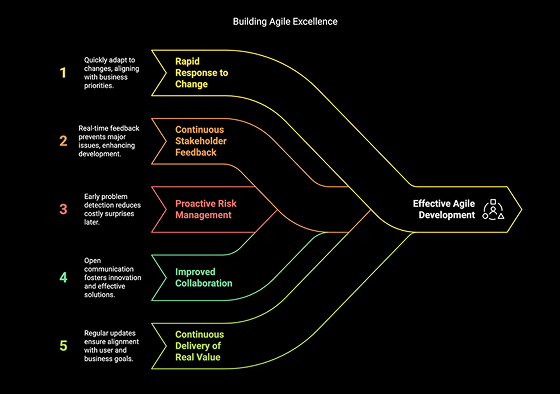Agile is adopted by many software teams that aspire to speed and flexibility, and generative AI makes their approach far more powerful. Unlike many data analysis tools, generative AI creates useful outputs such as well-defined templates and rich test scenarios. With AI deeply embedded in the Agile workflow, organizations can cut down on repetitive manual tasks and further improve efficiency while spending more time on complex problems.
The following article explores actual use cases of generative AI within Agile development and identifies key areas to focus on, such as quality control and responsible AI behaviors. Integrating AI within Agile is not about the latest trend for engineering teams. It is a comparative approach to developing high-quality software in less time.
What Is an Agile Team Structure?
Agile teams are intentionally small. Developers, product managers, designers, and QA work closely, sharing responsibility for deliverables. This daily collaboration, rather than siloed departments, ensures flexibility, quick adjustments, and consistent results without rigid processes.
Why Is Agility Crucial in Software Development?
There are several reasons as to why agility is crucial in software development, including:
- Rapid response to change: Agile methodology enables teams to promptly adjust to evolving requirements and technical problems while keeping projects on track with actual business priorities.
- Continuous stakeholder feedback: Software testing and adjustments happen in real-time through short iterative cycles, which allow stakeholders to observe software developments early and prevent major problems later on.
- Proactive risk management: Frequent check-ins make it easier to spot and fix problems early on, significantly lowering the chances of running into costly surprises late in the process.
- Improved collaboration: Agile promotes open and continuous communication among team members, improving coordination and creating an atmosphere for innovative and effective solutions.
- Continuous delivery of real value: Regular software releases demonstrate steady progress to stakeholders and ensure the final product stays aligned with evolving user expectations and business goals.

Generative AI’s Role in Agile Teams
Generative AI complements Agile teams by boosting productivity, reducing cognitive load, and accelerating decisions across the software lifecycle. Rather than replacing developers or testers, it fills gaps, handles repetitive tasks, and offers fresh ideas during creative blocks.
Key Areas Where Generative AI Supports Agile Teams
Some of the key areas in which GenAI supports agile teams include:
- Code generation and review: AI can produce boilerplate code, suggest functions, and provide real-time completions. It also reviews code for bugs, style, and performance, boosting speed without sacrificing quality.
- Automated testing support: From generating unit and integration test cases to mocking data and simulating edge scenarios, generative AI speeds up test coverage and helps uncover issues earlier in the sprint cycle.
- Story and task breakdown: Generative tools help product owners and scrum masters convert user stories into tasks, refine acceptance criteria, and suggest estimations from historical data.
- Documentation and knowledge transfer: Documentation often takes a backseat in Agile. AI can quickly generate API docs, onboarding guides, or release notes from code diffs or commits.
- Brainstorming and ideation: AI can quickly inspire UI designs, architecture options, or naming conventions, jumpstarting sprints and grooming the backlog.
Real-World Benefits of AI for Agile Teams
In practical terms, Agile teams using generative AI are seeing:
- Shorter sprint cycles: AI helps automate routine tasks and allows developers to focus on complex problem-solving.
- Improved developer experience: AI is a reliable pair programmer available 24/7.
- Better test coverage: With AI, a team can achieve better test coverage with minimal manual effort.
- Faster onboarding: AI-generated documentation and context explanations make knowledge transfer smoother for new employees.
- Enhanced creativity: During planning and retrospectives, AI can surface new ideas or alternatives that the team hadn’t considered.
AI amplifies Agile principles for fast-paced software development teams from startups to enterprises, driving better software faster.

Integrating Generative AI into Agile Practices
Agile values adaptability and collaboration, and generative AI fits well when used thoughtfully. It enhances human capability without disrupting team dynamics.
Practical Tips for Using AI in Agile Teams
To get started, Agile teams don’t need a complete process overhaul. Minor, strategic uses of AI can have an outsized impact:
- Automate the repetitive, not the creative: AI can handle low-level tasks like generating tests, formatting code, or building CRUD components, freeing developers from complex design work.
- Accelerate iterative design: In sprint planning or prototyping, AI quickly generates UI mocks, user flows, or design variations, enabling faster feedback, particularly in design-heavy work.
- Improve sprint planning with AI-generated estimates: AI can estimate tasks or suggest story breakdowns using past velocity and complexity data. It’s not a replacement for human judgment, but it speeds up discussions.
- Enrich backlog grooming sessions: Artificial intelligence helps identify dependencies between tasks while eliminating duplicates and turning vague user stories into clear acceptance criteria, which prepares items for development with minimal rework.
- Enhance retrospectives with smart summaries: Teams can use AI to summarize sprint insights, detect recurring blockers, and propose actions from past sprint patterns, cutting manual review time.
Ensuring Smooth Collaboration Between AI and Human Teams
Introducing AI tools into Agile workflows requires a conscious effort to maintain transparency, trust, and team culture.
- Set clear expectations for AI use: Define which tasks AI can assist with and where human oversight is required. This prevents over-reliance and avoids miscommunication around tool capabilities.
- Maintain a human-in-the-loop mindset: Team members should always review AI suggestions, especially for critical code, customer-facing features, or architectural decisions. Think of AI as a junior teammate: fast and helpful but needing review.
- Integrate AI into daily rituals: AI tools shouldn’t be separate from the team’s day-to-day work. Use them during stand-ups to auto-summarize blockers, in Jira/GitHub for task suggestions, or within IDEs for code generation.
- Monitor AI’s impact on team morale and productivity: Not everyone will embrace AI tools simultaneously. Keep feedback loops open-treat this as another Agile experiment. Adjust or swap out a tool if it isn’t working for the team.
Generative AI in Agile means working smarter, reducing friction, and freeing time for meaningful work. Teams that treat AI as collaborators see tangible gains in output and satisfaction.
Real-Life Examples
Agile teams across industries are already seeing the real-world impact of integrating generative AI into their workflows:
- Startup dev teams accelerating MVPs: A fintech startup used generative AI to prototype its mobile UI and generate backend APIs, cutting two weeks of work to four days and enabling faster testing and iteration without team burnout.
- Enterprise teams scaling test coverage: A logistics company used AI to auto-generate unit and integration tests during code reviews, boosting test coverage by 30% and reducing critical production bugs without adding testers.
- Agile agencies streamlining client delivery: A digital agency uses AI to automate content, docs, and boilerplate code, letting developers focus on personalized features, speeding delivery and boosting client satisfaction.
These stories reflect a growing pattern: teams that treat AI as a partner rather than a shortcut use it to reduce time-to-value, increase quality, and maintain Agile responsiveness even under pressure.
Challenges and future possibilities
Despite the benefits, integrating generative AI into Agile comes with risks and challenges, most of which are manageable with the right approach. Some of these risks include:
- Over-reliance and skill atrophy: Teams that lean too heavily on AI for code, design, or decision-making may see a decline in deep problem-solving or system design skills over time. To counter this, keep AI in support, not the driver.
- Bias and inaccuracy: AI can reflect bias or generate false information, leading to flawed logic or insecure code. To mitigate this, AI outputs should always be reviewed, especially in production-critical systems.
- Security and IP concerns: Generative tools may reuse public patterns, posing code originality or licensing risks. To mitigate such concerns, use trusted AI tools with clear data policies, especially for proprietary code.
- Team disruption and tool fatigue: Too many AI tools can overwhelm teams and fragment workflows. To ensure a smooth workflow, Introduce them gradually and ensure they fit your existing toolchain, like GitHub, Jira, Figma, or CI/CD.
Concluding thoughts
When used with intention, generative AI helps Agile teams speed up delivery, reduce routine work, and stay focused on solving real problems. It supports collaboration and takes care of repetitive tasks, acting more like a helpful assistant than a substitute. The advantage lies in blending AI’s capabilities with human insight, creativity, and a strong, collaborative team culture.

